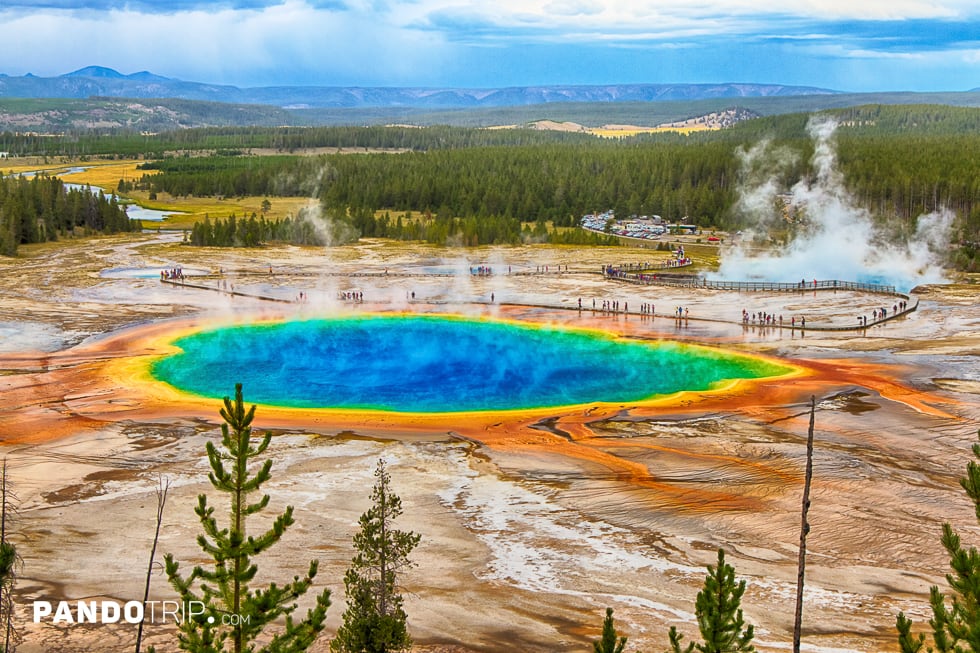Natural wonders, characterized by their unique geological and environmental features and high value, range from waterfalls and canyons to geothermal features and national parks. This article explores ten of the greatest natural wonders within the richly diverse continent of North America.
What is North America?
Typically, “North America” refers to three countries: Canada, the United States, and Mexico. However, depending on the context, this geographic scope can extend further. The United Nations officially divides North America into three regions: North America, Central America, and the Caribbean. In casual discourse, however, Central America is often excluded from the scope of the term. In this article, “North America” will encompass Canada, the United States, Mexico, and the countries within the Caribbean.
An overview of North America’s natural wonders
North America’s natural wonders are as diverse as the continent itself, with unique geographic features. From the mighty Niagara Falls to the intricate Sistema Sac Actun cave system in Mexico, these awe-inspiring sites invoke a sense of wonder with their breathtaking beauty. The following sections provide an in-depth exploration of ten of the most magnificent showcases of Mother Nature’s work across the continent, highlighting their distinctive characteristics.
1. Niagara Falls, Canada/USA

Niagara Falls isn’t a single waterfall, but a group of three cascades situated along the U.S.-Canada border, between New York and Ontario. The most impressive of the three is the Canadian or Horseshoe Falls, located on the Canadian side. This waterfall, standing at 51 meters (170 feet) high and stretching approximately 820 meters (2,700 feet) from one end to the other, is one of the most iconic landmarks in Canada.
On the American side of the border, you’ll find the American Falls. Adjacent to these falls, separated by natural forces, lies a smaller waterfall known as the Bridal Veil Falls. The American Falls measure 34 meters (110 feet) in height and span 335 meters (1,100 feet) in length.
You might wonder, “What makes Niagara Falls so special? After all, the world’s highest waterfall, Angel Falls in Venezuela, reaches a staggering 979 meters (3212 meters) high, and the widest, Khone Falls in Laos, spans an impressive 10,783 meters (35,376 feet) ! However, the reality is, even the tallest waterfalls in the world appear as tiny rivulets when compared to the sheer volume of Niagara. Similarly, the world’s widest waterfalls are comparable in height only to river rapids.
Few waterfalls can boast both significant height and width like Niagara. Comparable examples might include Iguazu Falls in South America or Victoria Falls in Africa. What sets Niagara Falls apart from other remarkable waterfalls is its unique location in the heart of a bustling city. Typically, waterfalls of such magnitude are nestled in remote locations, surrounded by unspoiled nature.



Furthermore, Niagara Falls can be experienced in numerous ways: swimming under the cascades, tunneling through to the other side, watching the light shows or the fireworks, and taking a cable car ride, to name just a few attractions. For these reasons, Niagara Falls is not only one of the world’s most famous natural wonders, but also one of its most visited destinations.
2. Grand Canyon, USA

The Grand Canyon is one of the world’s most magnificent natural wonders. It presents a vast and visually compelling landscape characterized by towering cliffs and a vibrant array of colors etched into its ancient rocks. Its color spectrum changes throughout the day, culminating in a stunning sunset.
Stretching more than 275 miles long, up to 18 miles wide, and reaching a depth of one mile, the Grand Canyon is unparalleled in the United States for its awe-inspiring beauty. Although it is not the steepest or longest canyon in the world, it is considered the most remarkable for its combination of scale, size, and beautifully colored landscape.
The Colorado River, the primary force behind the Grand Canyon’s formation, carved its way through the canyon roughly 17 million years ago. The river continues to shape the canyon today in an ongoing geologic evolution. Kayaking through the Colorado River provides a thrilling way to experience the canyon’s depths and is one of the top outdoor experiences in the US.
The Grand Canyon’s splendor can also be appreciated from above, thanks to numerous viewpoints. Mather Point, a short walk from the South Rim Visitor Center, is one of the park’s most popular overlooks. It provides an impressive introduction to the vastness of the Grand Canyon.

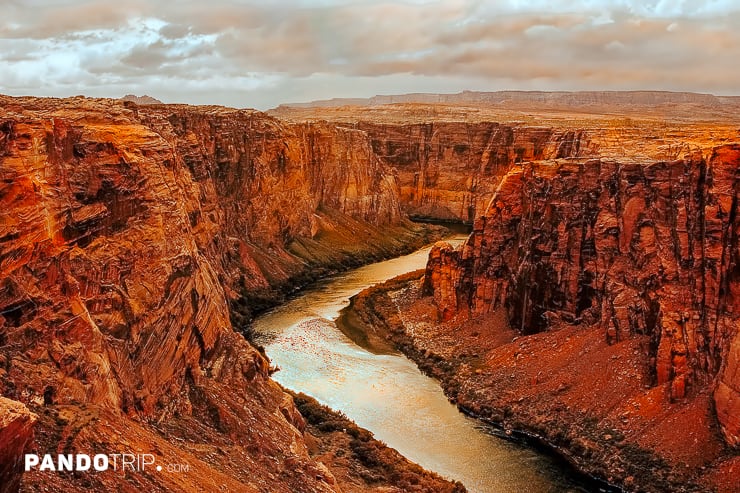

Beyond its geological marvels, the Grand Canyon also is also a paradise for waterfall enthusiasts. On the Havasupai Indian Reservation, adjacent to the Grand Canyon National Park, visitors can witness some of the world’s most stunning waterfalls. Whether it’s the crystal blue Havasu Falls or the green-blue Mooney Falls, these natural features are sure to captivate any visitor.
3. Geothermal features of Yellowstone National Park, USA

Yellowstone National Park covers approximately 2.2 million acres, or 8,983 square kilometers (3,472 square miles), making it larger than Rhode Island and Delaware combined. Established in 1872, Yellowstone National Park was not only the first national park in the United States but also in the world. Its establishment set a precedent, marking the first intentional preservation of natural wonders for future generations.
The park is situated over one of the world’s most active volcanic regions, known as the Yellowstone Caldera. Often referred to as a “supervolcano,” it’s one of the largest active volcanic systems globally. This system gives rise to the park’s iconic geothermal features.
Yellowstone National Park is home to an unparalleled collection of hot springs, geysers, mud pots, and fumaroles. Here, more than 10,000 hydrothermal features can be found, over 500 of which are geysers.
Old Faithful is perhaps the most famous geyser in the park and the world. This massive geyser can sometimes spew water up to 180 feet into the air. Remarkably predictable, Old Faithful typically erupts every 60-110 minutes. Its reliability is such that estimated eruption times are available online to help visitors plan their trip.




Another prominent geothermal feature is the Grand Prismatic Spring, the largest hot spring in the United States. It is known for its vibrant colors. Similarly colorful, but much smaller, is another hot spring in the park: Morning Glory Pool. Despite its size, it is no less visually striking.
4. Banff National Park, Canada

Banff National Park in Canada is a stunning natural treasure, overflowing with wonders that could fill more than one country. As Canada’s first national park, it is the flagship of the nation’s park system. Spanning 6,641 square kilometers (2,564 square miles) of stunning mountainous terrain, it’s nestled in the vast wilderness of the Canadian Rockies. While the Rockies also house other spectacular national parks such as Kootenay, Yoho, and Jasper, Banff National Park maintains its distinct allure.
Banff National Park hosts some of the most beautiful lakes in Canada, and arguably, the world. There are numerous lakes within the park, but two stand out as natural marvels – Lake Louise and Moraine Lake. Both are among the most recognizable landmarks in Canada, boasting stunning turquoise waters set against a breathtaking mountain backdrop. Other noteworthy lakes include Lake Minnewanka – the longest lake in the mountain parks of the Canadian Rockies, and Peyto Lake – renowned for its incredibly bright turquoise waters.
Glaciers further enhance the remarkable beauty of Banff National Park. The park is home to over 1,000 glaciers. A popular area for viewing glaciers is the Plain of Six Glaciers, where visitors can see several glaciers, including Lefroy Glacier, Pope’s Peak Glacier, and Aberdeen Glacier. A teahouse at the end of the Plain of Six Glaciers trail makes it a popular hiking destination. The Columbia Icefield, another well-known glacier, is one of the largest icefields in the Rocky Mountains. Although it is primarily located in Jasper National Park, it feeds eight major glaciers, including the renowned Athabasca Glacier.



There’s no shortage of natural wonders to discover in Banff National Park. From Johnston Canyon, which offers a serpentine hiking trail traversing bridges over rushing creeks and leading to two cascading waterfalls down steep cliff walls, to Sulphur Mountain that provides incredible bird’s-eye views of the town of Banff and the surrounding valley, Banff is a cornucopia of awe-inspiring beauty.
5. Sistema Sac Actun, Mexico
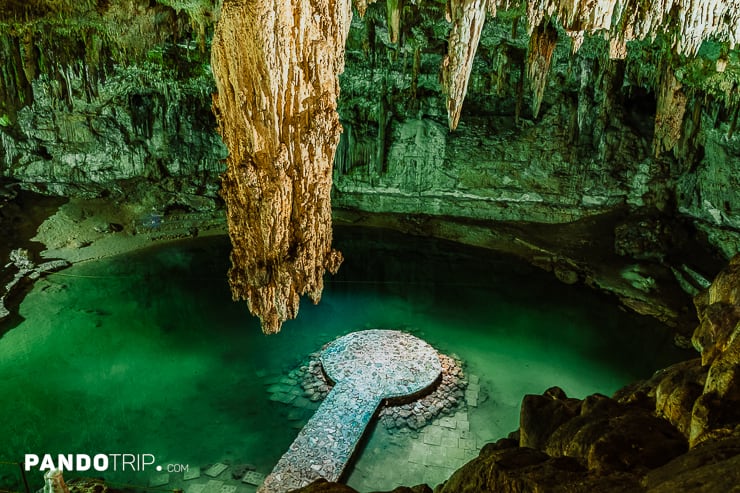
Sistema Sac Actun, located on the Yucatan Peninsula of Mexico, is one of the largest underwater cave systems in the world. Its name is derived from the Yucatec Maya language and translates to “White Cave System.”
The system spans more than 347 kilometers (216 miles) and has more than 220 cenotes. Located near the beach town of Tulum, it is believed to hold secrets of the Mayan civilization, with some theorizing that the Mayans may have perceived this system as a gateway to the underworld.
The cenotes, or natural sinkholes, within the Sistema Sac Actun attract visitors for all over the world due to their unique beauty and the opportunity to explore this extensive underwater cave system. Some of the most popular cenotes include Cenote Sac Actun, Cenote Dos Ojos, Gran Cenote, and Cenote Calavera. Cenote Dos Ojos is particularly famous. It consists of two connected sinkholes, giving it the name “Two Eyes”. The crystal-clear water, incredible underwater visibility, and unique rock formations make it one of most stunning places of the underwater world.
The exploration of the expansive Sistema Sac Actun began in 1987. In early 2007, it merged with the Sistema Nohoch Nah Chich, forming the world’s longest underwater cave system at the time. However, 2017 it was surpassed by the Sistema Ox Bel Ha, another system in Mexico.

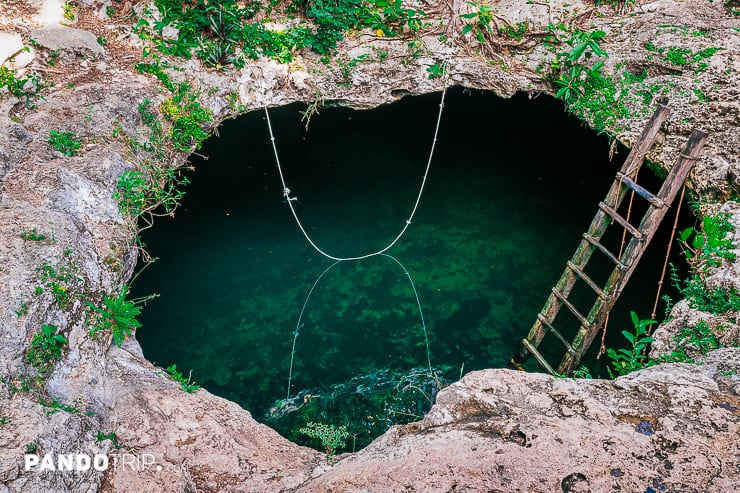

Since 2007, these two underwater caves have regularly competed for the title of longest system. In 2018, a connection between Sac Actun and Dos Ojos was discovered, pushing Sac Actun back into the position of the largest underwater system in the world, with a total length of 347 kilometers (216 miles). However, a report by CINDAQ (Centro Investigador del Sistema Acuífero de Quintana Roo A.C.) in early 2023 revealed that the Ox Bel Ha system had once again surpassed the Sac Actun system, this time with a total length of 436 kilometers. These cave systems continue to be explored and mapped, indicating potential further shifts in ranking in the future.
6. Landforms of Yosemite National Park, USA

Yosemite National Park, located in central California, spans a vast expanse of wilderness covering approximately 1,200 square miles (3,108 square kilometers). Despite its immense popularity with tourists, the park remains a beautifully preserved testament to the wonders of the natural world. Yosemite is celebrated for its diverse landscapes, including stunning rock formations, captivating waterfalls, vast valleys, and serene bodies of water.
The park’s impressive rock formations serve as monuments to the immense power of nature. Over thousands of years, rivers and glaciers have cut through granite, carving Yosemite’s valleys and shaping its mountains and rock formations. These natural processes have led to the creation of Yosemite Valley’s two most iconic landmarks: Half Dome and El Capitan.
Rising nearly 5,000 feet (1,524 meters) above the valley, Half Dome is a defining symbol of Yosemite. This famous formation resembles its namesake and looks like a rock dome that has been cut in half. El Capitan is another symbol of the park. At nearly 3,000 feet (914 meters) high, it is the tallest exposed vertical face of granite on Earth. These formations are especially popular with rock climbing enthusiasts. Although base jumping from the park’s cliffs has been banned since the 1970s, the thrill of the activity continues to attract adrenaline seekers.


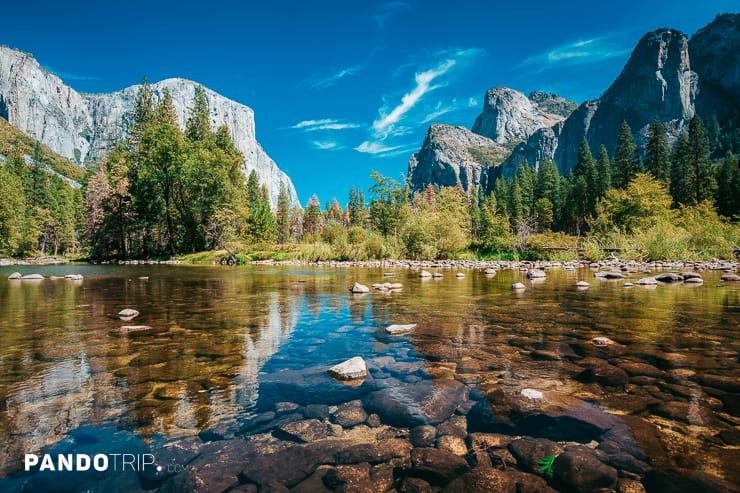
Yosemite is also known for its abundance of waterfalls, which range in size from massive cascades to smaller ones that only appear during periods of significant snowmelt. The park’s most famous waterfall is Yosemite Falls. At 2,425 feet (740 meters), it is the tallest waterfall in North America and one of the most spectacular waterfalls in the world.
7. St. Lucia Island

St. Lucia is arguably the most beautiful of all the Caribbean Islands. Known for its stunning beaches, jaw-dropping Piton mountains, lush rainforests, and the world’s only drive-in volcano, the island is a true natural wonder.
The Pitons are two mountainous volcanic plugs that serve as the most iconic feature not only of St. Lucia but also of the entire Caribbean. The twin peaks—Gros Piton and Petit Piton—rise dramatically from the sapphire-blue waters of the Caribbean near the town of Soufrière. As a designated World Heritage Site, the Pitons, together with the surrounding Pitons Management Area, invariably take the breath away from every visitor. The location is particularly beloved by mountain climbers. Gros Piton, the taller of the two at 770 meters (2,619 feet), is paradoxically easier to climb. The smaller Petit Piton, standing at 749 meters (2,461 feet), presents a more challenging journey.
The Pitons undoubtedly constitute the primary wonder of St. Lucia, but the island also boasts the world’s only drive-in volcano, Sulphur Springs. This volcano is unique in that, instead of bearing a pointy cone shape, it has a cratered appearance and a road that leads directly into it. The moment you enter, you’ll notice that the volcano is very much active. Glowing steam emits from the ground, creating a spectacular sight. Nearby, the Sulphur Springs hosts a river that has created a natural mud bath. This mud bath attracts visitors from all over the world due to its detoxifying and healing properties.

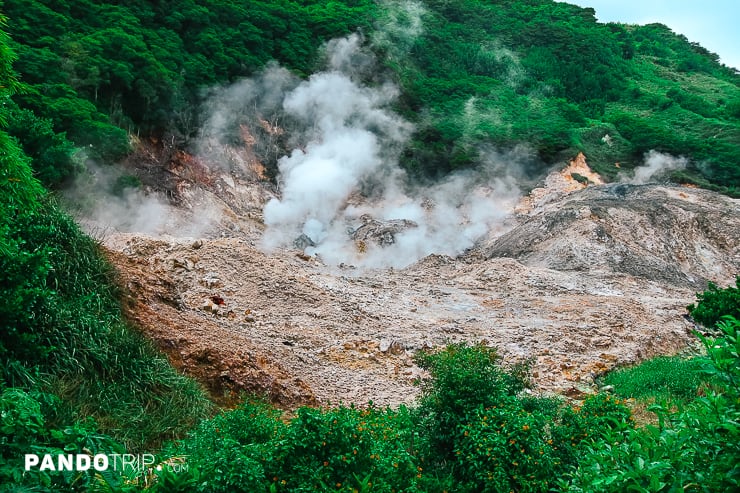

With its abundance of scenic coastline, Saint Lucia is a paradise for beach lovers. Beaches of white, gold, and even black sand contrast sharply with the azure sea, creating picturesque spots for vacationers. Marigot Bay is considered the best beach on the island. The beach was also featured in the famous Pirates of the Caribbean movie. The Lady’s Slipper Rock Arch at Marigot Bay is the exact spot where Johnny Depp encounters the hanging skeletons of captured pirates in the first film.
While the island is covered in soft white sand and surrounded by crystal clear waters, it also boasts an incredibly lush landscape. More than 70% of Saint Lucia is forested, and the country supports a rich variety of wildlife. These rainforests are particularly attractive to birdwatchers, hikers, and nature lovers.
8. Redwoods of Redwood National and State Parks, USA

Have you ever considered a tree as a wonder of nature? At first glance, trees may seem ordinary due to their abundance, but the Coast Redwoods, in particular, is a true marvel of the natural world. These are the tallest trees in the world, some reaching heights of 370 feet (112 metres)—taller than either Big Ben or the Statue of Liberty. The largest known Coast Redwood has a staggering volume of approximately 39,000 cubic feet, equivalent to the volume of 23 school buses. Furthermore, these trees exhibit remarkable longevity, with some living for over 2,000 years. Indeed, some extant Coast Redwoods date back to the era of the Roman Empire.
Interestingly, the world’s tallest tree species predominantly resides in California, one of the largest states in the USA. Northern California hosts a series of parks collectively referred to as the Redwood National and State Parks. These parks, which include Redwood National Park, Jedediah Smith Redwoods State Park, Del Norte Coast Redwoods State Park, and Prairie Creek Redwoods State Park, are home to approximately 45% of the world’s remaining old-growth redwoods.



The most famous among these majestic giants is the Hyperion, currently recognized as the tallest living tree on Earth. Discovered in 2006, Hyperion stands at a mind-boggling height of 379.7 feet (115.7 m). Another standout is the Corkscrew Tree, named for its unusual twisted shape, resembling a corkscrew. However, while admiring these natural wonders, one should not forget that sequoias are more than just trees; they form part of intricate ecosystems interacting with their environment. These ecosystems heavily rely on the presence and health of the redwoods to thrive.
9. Bay of Fundy, Canada
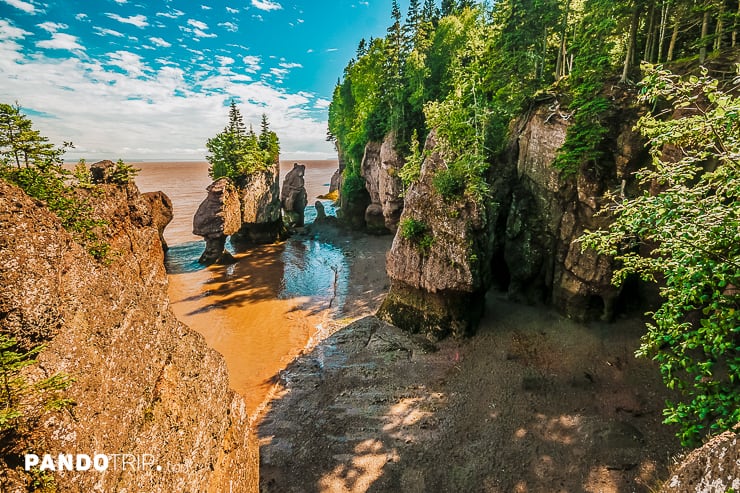
Imagine an area that is submerged by trillions of tones of water every day. It flows in relentlessly, flooding everything in its path, then recedes at an incredible speed, creating the largest whirlpools and eddies along the way. This dramatic fluctuation in water levels is the defining characteristic of the Bay of Fundy.
Known for the highest tides on Earth, the Bay of Fundy experiences a vertical tide range of up to 16 meters (approximately 54 feet). The force generated by these colossal tides is equivalent to the power of 8000 locomotives or 25 million horses. As the tide rises and falls, it creates an impressive sound known locally as the ‘Voice of the Moon’. Aptly named, this phenomenon is caused by the gravitational forces of the sun and moon. The tidal wave reaches its peak when the Earth, Moon, and Sun align—during the new or full Moon. The combined gravitational pulls of the Sun and Moon create a syzygy tide in which the water level rises twice a day, flooding the bay at high tide and receding at low tide.

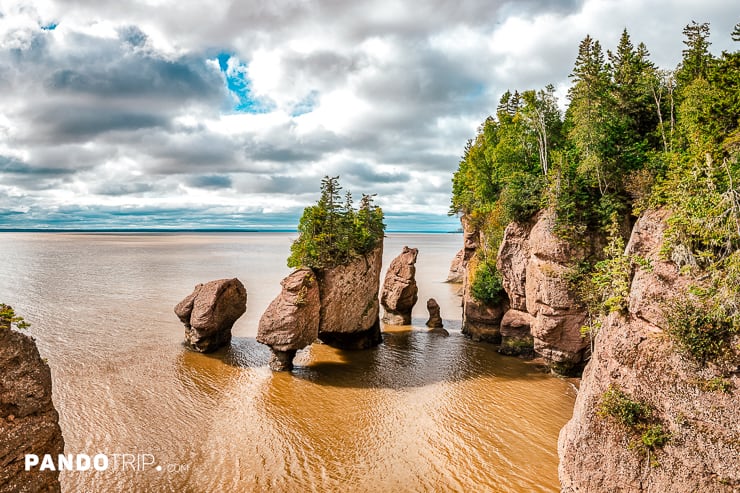

The enormous volume of water rushing in and out of the Bay of Fundy has sculpted a spectacular landscape of rocks and sea caves. One of the most iconic features of the Bay of Fundy is the Hopewell Rocks. Also known as the Flowerpot Rocks, they are a popular tourist attraction due to their unique formations caused by tidal erosion. At low tide, visitors can stroll along the ocean floor to marvel at these extraordinary geological formations. Yet at high tide, they vanish beneath the water, transforming into tiny islands crowned with solitary trees, providing an excellent opportunity for canoeing or boating.
10. The Bahamas
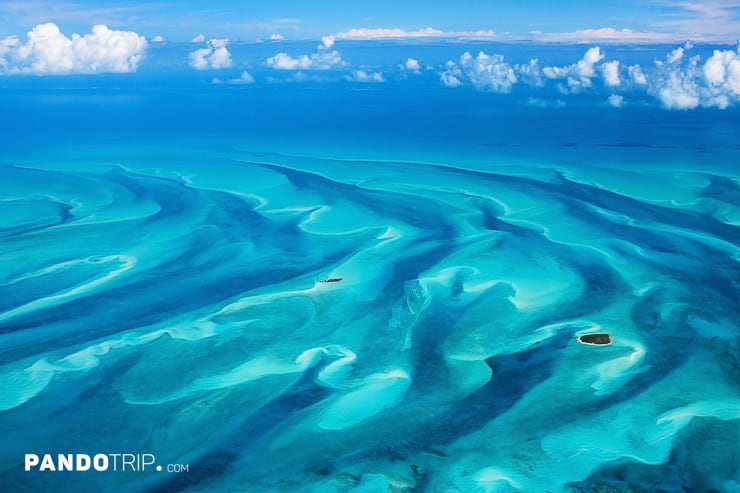
The Bahamas is an archipelago and an island country comprised of nearly 700 islands, of which only 30 are inhabited. Located in the western Atlantic Ocean, the Bahamas cover an area of 10,000 square kilometers (3,860 square miles), where the splendor of nature is boundless. Beneath the turquoise waters, travelers will find natural wonders like the great Andros Barrier Reef, unique blue holes, and even a pink sand beach.
Running parallel to the east coast of Andros, the Andros Barrier Reef is one of the largest barrier reefs in the world. Measuring approximately 300 km (190 miles) in length, the reef is home to a wide variety of marine life. It hosts more than 160 species of fish and coral, making it a favored destination for divers and snorkelers.
The Bahamas is also blessed with a record number of blue holes. These dark blue water circles are not gateways to a mystical underworld; rather, they are entrances to aquatic sinkholes and underwater caves. There are estimated to be more than 1,000 such caves in the Bahamas, with Dean’s Blue Hole being the most famous. At a depth of 202 meters (663 ft), it’s the world’s second deepest blue hole. The most spectacular thing about this blue hole is its surrounding beach, nestled within a natural rock amphitheater.
Beach enthusiasts will be captivated by the pink sand beach on Harbor Island. This beach is one of the most unique in the world, characterized by its distinctive pink sand. The sand’s almost indescribable pale pink color comes from microscopic coral insects known as foraminifera. Spanning about 3 miles (5 km) in length and around 100 feet (30 m) in width, Pink Sands Beach is distinctive among others. A unique feature of this beach is that the sand is always cool, inviting visitors to enjoy a leisurely barefoot stroll.



